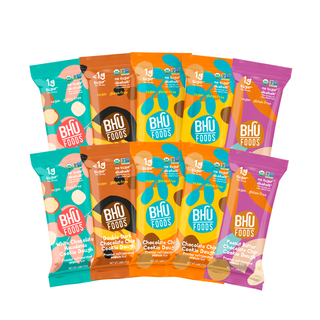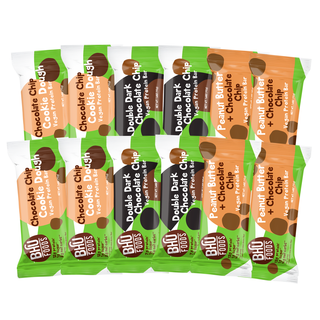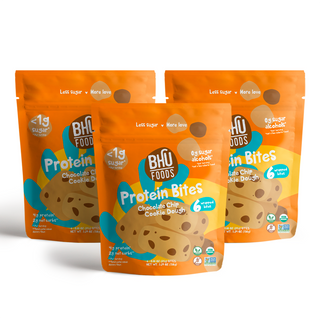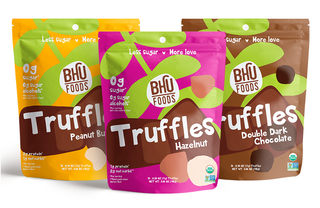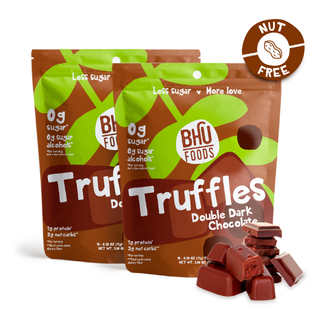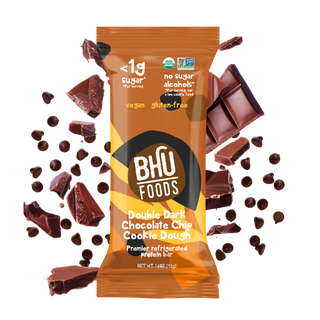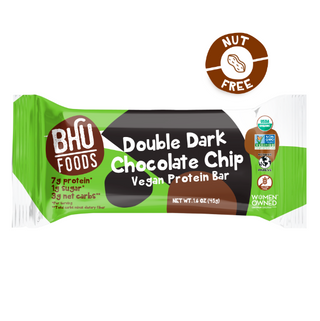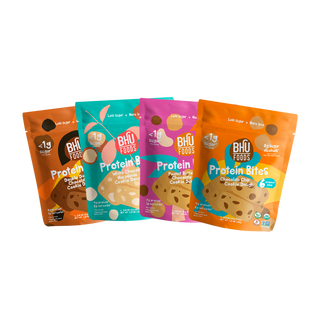
The Fearless Vegan - Interview with First Vegan to Scale Mt. Everest, Kuntal Joisher
Those who are passionate about the vegan lifestyle are sometimes driven to accomplish great achievements in the name of their cause. In the case of Kuntal Joisher, his cause was preventing cruelty to animals and helping reduce impact to our environment through veganism. Additionally, among his many accomplishments is being the first vegan to scale Mt. Everest. Discover a truly remarkable vegan who exemplifies the ideals of being dedicated, determined, and driven.
Kuntal was born in India to a family of Gujarati vegetarians. Although he was vegetarian from as early as he could remember, Kuntal describes the unique circumstance of only being a vegetarian due to the religion he was born into and how he eventually turned to veganism.
“I was born in a Gujarati Vegetarian family, and consequently raised a Vegetarian. However, I was a Vegetarian-by-religion, and not by choice. I would not eat eggs if I had to eat them in a more direct form such as an omelet, or boiled eggs etc. At the same time, if I had to eat a chocolate or an ice-cream or a cake which had eggs as an ingredient, I would happily eat it. I think this was a combination of convenience, taste, and above all apathy towards the animal rights cause.”
Although raised as a devout vegetarian, Kuntal would soon find that many of his dietary choices were in direct conflict with his own ethics. For many who make the switch to veganism, it’s a well-informed mentor who introduces them to the vegan lifestyle. In Kuntal’s case, it was a roommate he met while continuing his studies in Los Angeles.
“It was not until I moved to Los Angeles in 2001 to pursue my further studies that I got exposed to Veganism. One of my roommates at the university was an ethical vegetarian, and he exposed me to the horrors of dairy, eggs, and the leather industry. After doing my research, I connected the dots that there is no difference between a glass of milk, a block of cheese, or for that matter a piece of beef. At that point, I could not reconcile my compassionate thoughts with my cruel lifestyle as a vegetarian. The only way forward was to adopt a Vegan lifestyle.”
“I turned vegan overnight. The next few months of my life were a bit of a struggle. Before I transitioned to Vegan, I mostly ate out and majority of my diet was junk food which consisted of pizza's, burgers, french fries etc. Once I went Vegan, I had limited options eating out and so I had to shift to cooking at home. This was possibly best thing that happened to me as I started eating more vegetables, fruits, and whole grains!”
“Over the period of time I figured out quite a few vegan restaurants in the Los Angeles area, as well as several vegan options were already available at several restaurant chains. I also discovered places such as local markets, co-op grocery stores, Trader Joe's, as well as Whole Foods market to do my shopping. There were several vegan options as well as accidentally vegan options and I was on my way to become a lifelong vegan.”
In many ways, scaling Mt. Everest has become a pinnacle of human achievement. At 29,035 feet, Mt. Everest stands as the tallest mountain on Earth. But as astonishing as its height is, that’s not the reason why the mountain has claimed hundreds of lives of those who dare to climb it. The dangers of Mt. Everest lie in the hellacious cold, unpredictable weather, and the altitude sickness which causes a slew of health problems for climbers.
“My nutrition plan when I'm training is very simple – "Whole foods plant-based". Low fat, High carb. I love eating fruits, vegetables, beans, lentils, whole grains, nuts, and seeds and this diet has done wonders for me. I recover much quicker even when I do some of the most excruciating workouts. On the other side, every time I eat lots of unhealthy food such as deep-fried stuff / white refined flour, I've realized that my recovery becomes much slower. One's body tells it what it likes. And my body likes a whole food vegan diet.”
If you were about to go on a multi-day mountain trek, what would you pack? This can be a challenge in itself, especially for those whose diet is limited to plant-based options. Kuntal explains how climbs in the Himalayas have the added benefit of plenty of vegan foods to choose from.
“Regarding my diet while I'm climbing - a lot depends on where I'm climbing. If it's the Himalaya, then most of the local food tends to be Vegetarian, and it's easier to Veganize. The food typically comprises of Vegetable stews/curries, fruits, lentils, beans, soups, wheat bread/roti, rice, potatoes, pasta, noodles etc. So on my climbs in the Himalaya, I stick to eating the local cuisine. At the same time I do carry comfort food from home which tends to be trail mix of dried fruits and nuts, nutrition bars made out of dates and nuts, and a few local snacks even if they are unhealthy (after all on the mountain - calories are calories - you need them!).”
“For the Everest climb, at the Basecamp I ate pretty much everything fresh right from beaten rice, to semolina/oat porridge, deep fried Indian bread and curry, Tibetan bread, pancakes, Lentils and rice, pasta, french fries, burgers, and several Indian food items - all Vegan of course. Our awesome cooks Ngima Tamang and Anup Rai even baked us a Vegan cake!”
“Beyond Camp Two I survived on mainly few things: Unived RRUNN gels and sports nutrition drink, Outdoor Herbivore freeze dried meals, Oreo cookies, Dried Kiwi fruit pieces, cashews and some deep fried snack items.”
“In my opinion the best vegan foods (for indoors/outdoors for any kind of activity) are Fruits. My favorite fruit is Banana! It's a power packed fruit with a good balance of great carbs, fiber, and loads of potassium! One banana is about 100 calories, tastes amazing, digests easily, and can fuel any kind of crazy workout or adventure activity.”
“My next favorite fruit while hiking is Oranges. Great source of Vitamin C, carbs, and fiber! Again easy to digest and great tasting while on the trail. All this said -- all fruits are great for trails. Grapes, all kinds of berries, apples, pineapple etc. Just pick any you like and eat and hike! However, I mostly eat these on my hikes at sea level. It's not possible to get access to fresh fruits at 23,000 feet high up in the Himalayas! And tinned fruits are not convenient to carry.”
Fruits clearly rank highly on Kuntal’s list of his favorite vegan foods to pack for a long hike, but what else makes the list? Fruits are rich in vitamins, carbs, potassium, and other nutrients that are vital for maintaining high energy levels on a long trip, but they lack protein. Fortunately, Kuntal’s other favorites cover the protein he needs for an epic climb.
“Next up -- dry fruits, nuts and seeds. I love dates, raisins, dried figs and mix them with walnuts, almonds, peanuts, sesame seeds etc for a great GORP! Next up - Oatmeal. This is my go-to breakfast while hiking and climbing in the Himalayas. I practically eat this every single day. Great balance of carbs, proteins, and fibers.”
It’s common to expect extraordinary athletes to follow a strict dietary plan devoid of any imperfect foods. But the reality of being a mountaineer is that you typically burn about nine times more calories than the average person. This means that getting calories anyway possible is vital, even if they come from packaged, high-calorie treats. Kuntal explains his favorite ways to consume calories in a pinch when climbing to 23,000 feet:
“All this said -- a climber burns through about 18,000 calories on a typical Everest 20 hour round trip to the summit. For me as long as the food is vegan, I don't care whether it's healthy. I'll eat it as I need the calories. For example a small bottle of 250 ml coke = 100 calories (99% simple carbs). A single oreo cookie = 45 calories, and so about 20 of them would be around 900 calories! These are all calories and they taste great, and at 23,000 feet where most people can't eat anything, I would rather eat these and get my calories requirements met.”
There is no doubt that the vegan lifestyle is surging in popularity and more vegan athletes are accomplishing great feats than ever before. When asked if Kuntal ran into other vegan mountaineers on his adventures, he responded with a story about meeting another remarkable vegan athlete, the record holder for the fastest hike through the Pacific Crest Trail, Josh Garett.
“There are quite a few mountain climbers today who are vegan. Earlier this year I had an absolutely amazing time hiking alongside the legendary Vegan hiker - Josh Garett to Everest base camp in March 2017. In 2013, Josh broke the record for the overall fastest known time for a thru-hike of the Pacific Crest Trail, which traverses the West Coast of the United States from Campo, at the Mexican border, to Manning Park in British Columbia. Garrett started the 2663 mile hike on June 10, 2013, and finished on August 8, achieving the record with a time of 59 days, 8 hours and 14 minutes, averaging 45 miles per day. He was the first person to hike the trail in under 60 days."
"I again had an opportunity to climb alongside Josh in August earlier this year. This time our destination was Mt. Shashta in Northern California. Josh climbed the mountain from base camp to summit in mere 3.5 hours in his very basic trail running shoes! It is absolutely insane what this guy can pull off on a Vegan diet. I have no doubt that if Josh gains the necessary technical skills then he can break the speed record of climbing Mt. Everest and very much on a vegan diet!”
If you’re going to be climbing the world’s most perilous mountains and hiking exotic locations, it makes sense to also have a passion for photographing these experiences. In the case of Kuntal Joisher, he’s used these opportunities to their fullest advantage, providing photos for publications like National Geographic and BBC Earth among others. Although he’s adamant that his best work has yet to happen, these powerful images showcase his talent for photography.

“So we'd stopped just a few km before Kaas Plateau, and I was walking around enjoying the amazing panorama of peaks and greenery around. I suddenly ran into a group of cows and calves that were grazing, and their shepherd was just lying down nearby. I wanted to get shots of the grazing cows with the ghats and the dam as the background, and so I started moving gently towards them. A young calf got very nervous and tentative, and sensing my presence she gradually moved toward the comfort of her shepherd father. What happened next completely shocked me! She went near the shepherd and tried getting his attention. The shepherd momentarily woke up, saw me, and went back to sleep again, but put out his open hand, as if gesturing to the young bovine that "I'm here, don't worry". And the bovine reciprocated with a gentle lick of his hand showing unadulterated pure love! I was mesmerized by the scene and awestruck! Luckily I was able to capture the moment and even today when I look back at this picture, I'm just amazed and the one thing that comes to my mind is "Love knows no color, creed, race, gender, or species..."

“We had just completed walking over a tricky crevasse field above Camp 2 on Mt. Manaslu. A big snowstorm the night before meant that the fixed lines were completely under a meter of fresh snow. This also meant that we had to navigate without the safety of fixed lines. Just as we reached the end of this walk, I saw one of the most spectacular scenes of the entire climb. A couple of climbers were ascending through a gully with huge seracs above them, and Manaslu summit was peeking through the clouds!”

“My watch read 4am. I had been tossing and turning in my sleeping bag for the past 30 minutes. I wanted to pee badly. However, it was freaking cold outside and I was too lazy to do anything about it until it got to a point where I had to get out of my bag and just run. All this was happening at Everest base camp as I made my last attempt to climb Everest!”
“I unzipped the tent door and sprinted towards the toilet tent. I didn't even pay attention to the night sky. I finished the job and just as I exited the tent my eyes fell upon the sky. Billions of stars in front of me. And the milky way was shining in all its glory! And this is how most nights at Everest base camp are - mind boggling, insane, crazy, awesome, magical - words fall short. And guess what? - within the next five minutes, I had already counted two shooting stars! I spent the next hour out in the cold just soaking in the beautiful views and spending time shooting this picture.”
“One of the biggest reasons I photograph is so that I can share the beauty of our world, and inspire people to go experience it for themselves. My hope is that once people experience nature, mountains, wilderness and understand how important they are to our survival - both physical and spiritual, they would automatically become conscious of the everyday choices they make and try and conserve our beautiful planet.
My one piece of advice to anyone wanting to take up photography is that it's an art that's not about how fancy your camera is, or how expensive your lens is; photography is all about expressing how you perceive this world. So, go grab a camera and start capturing the magical moments before it's too late.”
Kuntal Joisher climbed the world’s tallest mountain with a very specific purpose in mind. Finally having made it to the peak of Mount Everest, Kuntal reflects on the significance of his accomplishment and what it means to vegans throughout the world.
“Standing on top of the world with a Vegan flag in my hand is my very very very small contribution to the cause that changed my entire life. However, let me make it very clear. I climbed Everest to prove that the Vegan diet does not lack nutrition and can support the most difficult physical endurance endeavors of the planet. At the same time, I am not saying that the Vegan diet is superior to any other diet. If I can climb Everest as a Vegan, then I can assure that there are no problems with the vegan diet.”
“For the animals: Being vegan is about living a lifestyle that does not cause suffering, harm or death to animals, and allowing animals to be free to choose the way they want to live. Other animals are sentient beings like us, with their own needs, desires, and interests. We now know that like us, they can experience a wide range of sensations and emotions such as happiness, pain, pleasure, fear, hunger, sadness, boredom, frustration or contentment. They are aware of the world and what happens to them matters to them. Their lives have intrinsic value - they are not inferior beings nor just here as resources or tools for human use.
All use of animals for food, clothing, entertainment, pets or experimentation involves utilizing animals against their will, and - in the vast majority of cases - involves their suffering and deaths. We are brought up to believe in our current society that we need to consume or make use of other animals but this is neither ethical nor necessary. Instead, vegans choose to live a lifestyle that respects other animals as sentient individuals whose lives have meaning and do not consume, wear or use animal products or take part in activities which exploit animals. Today, being vegan is easy, proven to be healthy, and needn't cost more.”
“For our planet: The production of meat and other animal products places a heavy burden on the environment - from crops and water required to feed the animals, to the transport and other processes involved from farm to fork. The vast amount of grain feed required for meat production is a significant contributor to deforestation, habitat loss and species extinction. In Brazil alone, the equivalent of 5.6 million acres of land is used to grow soya beans for animals in Europe. This land contributes to developing world malnutrition by driving impoverished populations to grow cash crops for animal feed, rather than food for themselves. On the other hand, considerably lower quantities of crops and water are required to sustain a vegan diet, making the switch to veganism one of the easiest, most enjoyable, and most effective ways to reduce our impact on the environment.”
“I tried climbing Everest twice - in 2014, and 2015. Both times the climb was canceled due to natural disasters. Several people posted trying to dissuade me from climbing saying -- "the mountain doesn’t want you there", and some even said - "You don't have what it takes". I didn't listen to them. Instead, I kept the fire inside me burning, trained harder than ever, never gave up on my dream, and finally made it to the top! The lesson I learned is that one should never give up on their dream. People will say things such as - you are crazy, it’s impossible, you are sure to fail, etc. And a lot of those things will happen. But if you want to achieve your dream you have to nurture and protect it like your baby, work and train hard and smart, learn from your failures, and keep going at it until you reach to the top! I would like to quote my favorite mountaineer - Ed Viesturs - "There are NO shortcuts to the top!"
“Also whether it's running a business or climbing a mountain, we are so focused on getting to the top that we forget to live in the present and enjoy the journey we took to get there. Now don't get me wrong, getting to the top is important and extremely rewarding. Having a dream or a goal to pursue gives direction and focus to your journey and that is necessary. Since I began spending more time in the mountain wilderness, I've started living in the present, enjoying and learning from every moment and living life as if there is no tomorrow. I realized that every destination segues into a new journey, thus making life an endless journey that needs to be lived fully.”
The Best Time to Pursue your Dreams
“And this attitude got reinforced when I escaped from a sure death in a 2015 avalanche. That night when I went to sleep – my entire life played out in front of me. And I realized one thing - if you have any dreams or passions, the best time to do them is now, not tomorrow, not the day after, not in 60 years when you have all the time and money saved. Now.”
In the mediums of mountain climbing and photography, Kuntal Joisher found ways to accomplish extraordinary achievements for his cause. We’re not all mountaineers, but everyone can challenge themselves to learn more, follow their dreams, and become better versions of themselves. Whether it’s striving to develop plant-based foods that make the world a better place or doing things that no one else has accomplished, we wish you luck in conquering your dreams, whatever they may be.

Kuntal’s Upbringing as a Gujarati Vegetarian
Kuntal was born in India to a family of Gujarati vegetarians. Although he was vegetarian from as early as he could remember, Kuntal describes the unique circumstance of only being a vegetarian due to the religion he was born into and how he eventually turned to veganism.
“I was born in a Gujarati Vegetarian family, and consequently raised a Vegetarian. However, I was a Vegetarian-by-religion, and not by choice. I would not eat eggs if I had to eat them in a more direct form such as an omelet, or boiled eggs etc. At the same time, if I had to eat a chocolate or an ice-cream or a cake which had eggs as an ingredient, I would happily eat it. I think this was a combination of convenience, taste, and above all apathy towards the animal rights cause.”
Kuntal Recalls How He Became Vegan
Although raised as a devout vegetarian, Kuntal would soon find that many of his dietary choices were in direct conflict with his own ethics. For many who make the switch to veganism, it’s a well-informed mentor who introduces them to the vegan lifestyle. In Kuntal’s case, it was a roommate he met while continuing his studies in Los Angeles.
“It was not until I moved to Los Angeles in 2001 to pursue my further studies that I got exposed to Veganism. One of my roommates at the university was an ethical vegetarian, and he exposed me to the horrors of dairy, eggs, and the leather industry. After doing my research, I connected the dots that there is no difference between a glass of milk, a block of cheese, or for that matter a piece of beef. At that point, I could not reconcile my compassionate thoughts with my cruel lifestyle as a vegetarian. The only way forward was to adopt a Vegan lifestyle.”
The Early Challenges with Going and Staying Vegan
“I turned vegan overnight. The next few months of my life were a bit of a struggle. Before I transitioned to Vegan, I mostly ate out and majority of my diet was junk food which consisted of pizza's, burgers, french fries etc. Once I went Vegan, I had limited options eating out and so I had to shift to cooking at home. This was possibly best thing that happened to me as I started eating more vegetables, fruits, and whole grains!”
The Transition to Veganism Gets Easier
“Over the period of time I figured out quite a few vegan restaurants in the Los Angeles area, as well as several vegan options were already available at several restaurant chains. I also discovered places such as local markets, co-op grocery stores, Trader Joe's, as well as Whole Foods market to do my shopping. There were several vegan options as well as accidentally vegan options and I was on my way to become a lifelong vegan.”
Life as a Vegan Mountaineer - How Kuntal Scaled Mt. Everest
In many ways, scaling Mt. Everest has become a pinnacle of human achievement. At 29,035 feet, Mt. Everest stands as the tallest mountain on Earth. But as astonishing as its height is, that’s not the reason why the mountain has claimed hundreds of lives of those who dare to climb it. The dangers of Mt. Everest lie in the hellacious cold, unpredictable weather, and the altitude sickness which causes a slew of health problems for climbers.
How Does Kuntal Eat when Training?
“My nutrition plan when I'm training is very simple – "Whole foods plant-based". Low fat, High carb. I love eating fruits, vegetables, beans, lentils, whole grains, nuts, and seeds and this diet has done wonders for me. I recover much quicker even when I do some of the most excruciating workouts. On the other side, every time I eat lots of unhealthy food such as deep-fried stuff / white refined flour, I've realized that my recovery becomes much slower. One's body tells it what it likes. And my body likes a whole food vegan diet.”
Location Matters as a Vegan Mountaineer
If you were about to go on a multi-day mountain trek, what would you pack? This can be a challenge in itself, especially for those whose diet is limited to plant-based options. Kuntal explains how climbs in the Himalayas have the added benefit of plenty of vegan foods to choose from.
“Regarding my diet while I'm climbing - a lot depends on where I'm climbing. If it's the Himalaya, then most of the local food tends to be Vegetarian, and it's easier to Veganize. The food typically comprises of Vegetable stews/curries, fruits, lentils, beans, soups, wheat bread/roti, rice, potatoes, pasta, noodles etc. So on my climbs in the Himalaya, I stick to eating the local cuisine. At the same time I do carry comfort food from home which tends to be trail mix of dried fruits and nuts, nutrition bars made out of dates and nuts, and a few local snacks even if they are unhealthy (after all on the mountain - calories are calories - you need them!).”
What Do You Eat Before the Climb of a Lifetime?
“For the Everest climb, at the Basecamp I ate pretty much everything fresh right from beaten rice, to semolina/oat porridge, deep fried Indian bread and curry, Tibetan bread, pancakes, Lentils and rice, pasta, french fries, burgers, and several Indian food items - all Vegan of course. Our awesome cooks Ngima Tamang and Anup Rai even baked us a Vegan cake!”
Beyond Camp Two - Eating to Survive on Mt. Everest
“Beyond Camp Two I survived on mainly few things: Unived RRUNN gels and sports nutrition drink, Outdoor Herbivore freeze dried meals, Oreo cookies, Dried Kiwi fruit pieces, cashews and some deep fried snack items.”
Which Vegan Food Group Does Kuntal Prefer for the Outdoors?
“In my opinion the best vegan foods (for indoors/outdoors for any kind of activity) are Fruits. My favorite fruit is Banana! It's a power packed fruit with a good balance of great carbs, fiber, and loads of potassium! One banana is about 100 calories, tastes amazing, digests easily, and can fuel any kind of crazy workout or adventure activity.”
“All Fruits are Great for Trails”
“My next favorite fruit while hiking is Oranges. Great source of Vitamin C, carbs, and fiber! Again easy to digest and great tasting while on the trail. All this said -- all fruits are great for trails. Grapes, all kinds of berries, apples, pineapple etc. Just pick any you like and eat and hike! However, I mostly eat these on my hikes at sea level. It's not possible to get access to fresh fruits at 23,000 feet high up in the Himalayas! And tinned fruits are not convenient to carry.”
What Hiking Foods Does Kuntal Recommend Besides Fruits?
Fruits clearly rank highly on Kuntal’s list of his favorite vegan foods to pack for a long hike, but what else makes the list? Fruits are rich in vitamins, carbs, potassium, and other nutrients that are vital for maintaining high energy levels on a long trip, but they lack protein. Fortunately, Kuntal’s other favorites cover the protein he needs for an epic climb.
“Next up -- dry fruits, nuts and seeds. I love dates, raisins, dried figs and mix them with walnuts, almonds, peanuts, sesame seeds etc for a great GORP! Next up - Oatmeal. This is my go-to breakfast while hiking and climbing in the Himalayas. I practically eat this every single day. Great balance of carbs, proteins, and fibers.”
Even Legendary Mountaineers Indulge in Sweets
It’s common to expect extraordinary athletes to follow a strict dietary plan devoid of any imperfect foods. But the reality of being a mountaineer is that you typically burn about nine times more calories than the average person. This means that getting calories anyway possible is vital, even if they come from packaged, high-calorie treats. Kuntal explains his favorite ways to consume calories in a pinch when climbing to 23,000 feet:
“All this said -- a climber burns through about 18,000 calories on a typical Everest 20 hour round trip to the summit. For me as long as the food is vegan, I don't care whether it's healthy. I'll eat it as I need the calories. For example a small bottle of 250 ml coke = 100 calories (99% simple carbs). A single oreo cookie = 45 calories, and so about 20 of them would be around 900 calories! These are all calories and they taste great, and at 23,000 feet where most people can't eat anything, I would rather eat these and get my calories requirements met.”
Vegan Athletes Join for a Hike
There is no doubt that the vegan lifestyle is surging in popularity and more vegan athletes are accomplishing great feats than ever before. When asked if Kuntal ran into other vegan mountaineers on his adventures, he responded with a story about meeting another remarkable vegan athlete, the record holder for the fastest hike through the Pacific Crest Trail, Josh Garett.
“There are quite a few mountain climbers today who are vegan. Earlier this year I had an absolutely amazing time hiking alongside the legendary Vegan hiker - Josh Garett to Everest base camp in March 2017. In 2013, Josh broke the record for the overall fastest known time for a thru-hike of the Pacific Crest Trail, which traverses the West Coast of the United States from Campo, at the Mexican border, to Manning Park in British Columbia. Garrett started the 2663 mile hike on June 10, 2013, and finished on August 8, achieving the record with a time of 59 days, 8 hours and 14 minutes, averaging 45 miles per day. He was the first person to hike the trail in under 60 days."
"I again had an opportunity to climb alongside Josh in August earlier this year. This time our destination was Mt. Shashta in Northern California. Josh climbed the mountain from base camp to summit in mere 3.5 hours in his very basic trail running shoes! It is absolutely insane what this guy can pull off on a Vegan diet. I have no doubt that if Josh gains the necessary technical skills then he can break the speed record of climbing Mt. Everest and very much on a vegan diet!”
Kuntal’s Passion for Photography
If you’re going to be climbing the world’s most perilous mountains and hiking exotic locations, it makes sense to also have a passion for photographing these experiences. In the case of Kuntal Joisher, he’s used these opportunities to their fullest advantage, providing photos for publications like National Geographic and BBC Earth among others. Although he’s adamant that his best work has yet to happen, these powerful images showcase his talent for photography.
Kuntal Reveals Three of His Favorite Photos He’s Taken

Cow and Shepherd
“So we'd stopped just a few km before Kaas Plateau, and I was walking around enjoying the amazing panorama of peaks and greenery around. I suddenly ran into a group of cows and calves that were grazing, and their shepherd was just lying down nearby. I wanted to get shots of the grazing cows with the ghats and the dam as the background, and so I started moving gently towards them. A young calf got very nervous and tentative, and sensing my presence she gradually moved toward the comfort of her shepherd father. What happened next completely shocked me! She went near the shepherd and tried getting his attention. The shepherd momentarily woke up, saw me, and went back to sleep again, but put out his open hand, as if gesturing to the young bovine that "I'm here, don't worry". And the bovine reciprocated with a gentle lick of his hand showing unadulterated pure love! I was mesmerized by the scene and awestruck! Luckily I was able to capture the moment and even today when I look back at this picture, I'm just amazed and the one thing that comes to my mind is "Love knows no color, creed, race, gender, or species..."

Manaslu
“We had just completed walking over a tricky crevasse field above Camp 2 on Mt. Manaslu. A big snowstorm the night before meant that the fixed lines were completely under a meter of fresh snow. This also meant that we had to navigate without the safety of fixed lines. Just as we reached the end of this walk, I saw one of the most spectacular scenes of the entire climb. A couple of climbers were ascending through a gully with huge seracs above them, and Manaslu summit was peeking through the clouds!”

Everest Milky Way
“My watch read 4am. I had been tossing and turning in my sleeping bag for the past 30 minutes. I wanted to pee badly. However, it was freaking cold outside and I was too lazy to do anything about it until it got to a point where I had to get out of my bag and just run. All this was happening at Everest base camp as I made my last attempt to climb Everest!”
“I unzipped the tent door and sprinted towards the toilet tent. I didn't even pay attention to the night sky. I finished the job and just as I exited the tent my eyes fell upon the sky. Billions of stars in front of me. And the milky way was shining in all its glory! And this is how most nights at Everest base camp are - mind boggling, insane, crazy, awesome, magical - words fall short. And guess what? - within the next five minutes, I had already counted two shooting stars! I spent the next hour out in the cold just soaking in the beautiful views and spending time shooting this picture.”
Kuntal’s Advice for New Photographers?
“One of the biggest reasons I photograph is so that I can share the beauty of our world, and inspire people to go experience it for themselves. My hope is that once people experience nature, mountains, wilderness and understand how important they are to our survival - both physical and spiritual, they would automatically become conscious of the everyday choices they make and try and conserve our beautiful planet.
My one piece of advice to anyone wanting to take up photography is that it's an art that's not about how fancy your camera is, or how expensive your lens is; photography is all about expressing how you perceive this world. So, go grab a camera and start capturing the magical moments before it's too late.”
What Does Kuntal’s Success Mean to the Vegan Cause?
Kuntal Joisher climbed the world’s tallest mountain with a very specific purpose in mind. Finally having made it to the peak of Mount Everest, Kuntal reflects on the significance of his accomplishment and what it means to vegans throughout the world.
“Standing on top of the world with a Vegan flag in my hand is my very very very small contribution to the cause that changed my entire life. However, let me make it very clear. I climbed Everest to prove that the Vegan diet does not lack nutrition and can support the most difficult physical endurance endeavors of the planet. At the same time, I am not saying that the Vegan diet is superior to any other diet. If I can climb Everest as a Vegan, then I can assure that there are no problems with the vegan diet.”
Kuntal Explains Two Strong Reasons for Going Vegan
“For the animals: Being vegan is about living a lifestyle that does not cause suffering, harm or death to animals, and allowing animals to be free to choose the way they want to live. Other animals are sentient beings like us, with their own needs, desires, and interests. We now know that like us, they can experience a wide range of sensations and emotions such as happiness, pain, pleasure, fear, hunger, sadness, boredom, frustration or contentment. They are aware of the world and what happens to them matters to them. Their lives have intrinsic value - they are not inferior beings nor just here as resources or tools for human use.
All use of animals for food, clothing, entertainment, pets or experimentation involves utilizing animals against their will, and - in the vast majority of cases - involves their suffering and deaths. We are brought up to believe in our current society that we need to consume or make use of other animals but this is neither ethical nor necessary. Instead, vegans choose to live a lifestyle that respects other animals as sentient individuals whose lives have meaning and do not consume, wear or use animal products or take part in activities which exploit animals. Today, being vegan is easy, proven to be healthy, and needn't cost more.”
“For our planet: The production of meat and other animal products places a heavy burden on the environment - from crops and water required to feed the animals, to the transport and other processes involved from farm to fork. The vast amount of grain feed required for meat production is a significant contributor to deforestation, habitat loss and species extinction. In Brazil alone, the equivalent of 5.6 million acres of land is used to grow soya beans for animals in Europe. This land contributes to developing world malnutrition by driving impoverished populations to grow cash crops for animal feed, rather than food for themselves. On the other hand, considerably lower quantities of crops and water are required to sustain a vegan diet, making the switch to veganism one of the easiest, most enjoyable, and most effective ways to reduce our impact on the environment.”
Final Thoughts from the Vegan Mountaineer, Kuntal Joisher
“I tried climbing Everest twice - in 2014, and 2015. Both times the climb was canceled due to natural disasters. Several people posted trying to dissuade me from climbing saying -- "the mountain doesn’t want you there", and some even said - "You don't have what it takes". I didn't listen to them. Instead, I kept the fire inside me burning, trained harder than ever, never gave up on my dream, and finally made it to the top! The lesson I learned is that one should never give up on their dream. People will say things such as - you are crazy, it’s impossible, you are sure to fail, etc. And a lot of those things will happen. But if you want to achieve your dream you have to nurture and protect it like your baby, work and train hard and smart, learn from your failures, and keep going at it until you reach to the top! I would like to quote my favorite mountaineer - Ed Viesturs - "There are NO shortcuts to the top!"
Learning to Live in the Present
“Also whether it's running a business or climbing a mountain, we are so focused on getting to the top that we forget to live in the present and enjoy the journey we took to get there. Now don't get me wrong, getting to the top is important and extremely rewarding. Having a dream or a goal to pursue gives direction and focus to your journey and that is necessary. Since I began spending more time in the mountain wilderness, I've started living in the present, enjoying and learning from every moment and living life as if there is no tomorrow. I realized that every destination segues into a new journey, thus making life an endless journey that needs to be lived fully.”
The Best Time to Pursue your Dreams
“And this attitude got reinforced when I escaped from a sure death in a 2015 avalanche. That night when I went to sleep – my entire life played out in front of me. And I realized one thing - if you have any dreams or passions, the best time to do them is now, not tomorrow, not the day after, not in 60 years when you have all the time and money saved. Now.”
Best of Luck in Finding Your Purpose and Passions
In the mediums of mountain climbing and photography, Kuntal Joisher found ways to accomplish extraordinary achievements for his cause. We’re not all mountaineers, but everyone can challenge themselves to learn more, follow their dreams, and become better versions of themselves. Whether it’s striving to develop plant-based foods that make the world a better place or doing things that no one else has accomplished, we wish you luck in conquering your dreams, whatever they may be.





